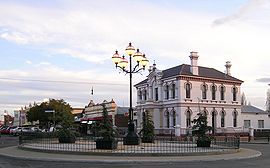Glen Innes, New South Wales
|
Glen Innes New South Wales |
|||||||
|---|---|---|---|---|---|---|---|

Grey Street, Glen Innes
|
|||||||
| Coordinates | 29°45′00″S 151°44′10″E / 29.75000°S 151.73611°ECoordinates: 29°45′00″S 151°44′10″E / 29.75000°S 151.73611°E | ||||||
| Population | 5,173 (2011 census) | ||||||
| Established | 1852 | ||||||
| Postcode(s) | 2370 | ||||||
| Elevation | 1,062 m (3,484 ft) | ||||||
| Time zone | AEST (UTC+10) | ||||||
| • Summer (DST) | AEDT (UTC+11) | ||||||
| Location | |||||||
| LGA(s) | Glen Innes Severn Shire Council | ||||||
| County | Gough | ||||||
| State electorate(s) | Northern Tablelands | ||||||
| Federal Division(s) | New England | ||||||
|
|||||||
Glen Innes is a parish and town on the Northern Tablelands, in the New England region of New South Wales, Australia. It is the centre of the Glen Innes Severn Shire Council. The town is located at the intersection of the New England Highway and the Gwydir Highway. At the 2011 census, Glen Innes had a population of 5,173.
The original owners of Glen Innes and surrounding areas are the Ngarabal people. The Ngarabal name of the township of Glen Innes is Gindaaydjin, meaning "plenty of big round stones on clear plains". The arrival of European settlers saw the significant disruption of the life of Ngarabal people, with widespread loss of life through massacres, disease and poisoning. Many Ngarabal people continue to live in the Glen Innes area, still practising many aspects of their traditional culture and way of life.
In about 1838 Archibald Boyd registered the first run in the Glen Innes district. Two stockmen known as "the Beardies" because of their long beards took Boyd to this area to establish his run. ‘The Beardies’ later introduced other squatters to the best runs in the area to become known as the Land of the Beardies or Beardie Plains.
Furracabad Station was suggested by John James Galloway as an alternative to Wellingrove for a new town. However Furracabad Station was sold in the 1840s depression and passed to Major Archibald Clunes Innes, then to the Bank of Australasia, then to John Major, who sold it to Archibald Mosman. The name Glen Innes is believed to be bestowed by Mosman in honour of Innes. Glen Innes was gazetted as a town in 1852 and the first lots were sold in 1854. The post office was established in August 1854 and the court in 1858 when they replaced the Wellingrove offices. In 1866 the population was about 350, with a telegraph station, lands office, police barracks, courthouse, post office and two hotels. There was still no coach service at this time, but in the 1870s a road was constructed to Grafton.
...
Wikipedia

